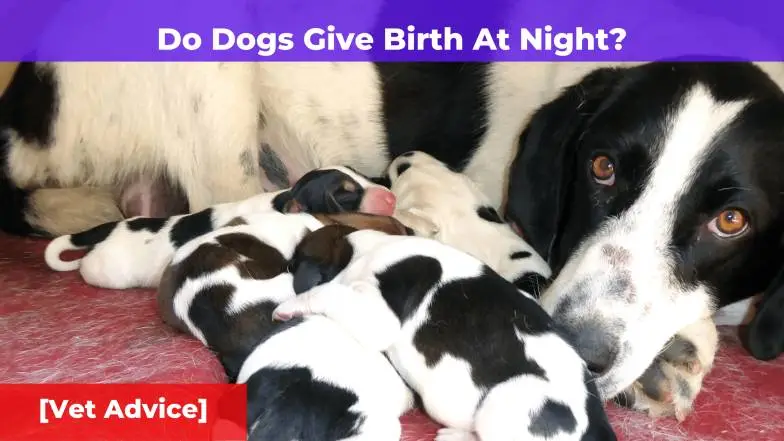It’s always a joy when your furry friend becomes a proud mother of adorable puppies. However, a pregnant pet in the household brings a new set of responsibilities for you to consider.
Dogs typically give birth at night, although this is not always the case. A drop in temperature, restlessness, vomiting, shivering, and panting are some common signs of labor in your pooch.
It’s crucial to contact your veterinarian and seek advice on labor, as well as provide a calm and comfortable environment for your furry friend during labor.
In this article, we’ll explore whether dogs give birth at day or night, the signs of canine labor, and how to take care of your pooch during this critical time. By following the right approach and taking the necessary precautions, you can ensure that your furry friend and her puppies have a safe and healthy delivery.
So, let’s dive into the world of canine pregnancy and learn how to be the best pet parent possible.
Do dogs give birth at night?
Dogs often give birth at night, although we can not precisely guess the labor time.
The gestation period of dogs or the duration of pregnancy is 63 days( 60- 65 days on average). Knowing the gestation period is essential, then you can assume the tentative day of labor. However, the time of labor is hard to guess.
Labor can happen in the daytime or nighttime, according to your pooch. However, let’s find out why labor usually occurs at night.
Why do dogs often give birth at night?
There is a scientific reason for birth to be induced at night. Have you heard of melatonin? Brians of mammals secretes the hormone melatonin. It is one of the main controllers of the body’s circadian rhythms, or simply it controls the sleep-wake cycle of animals.
Melatonin secretion is higher during the night, which induces sleep, and is lower during the day. Melatonin has a special function in pregnant animals.
The muscles in the uterus have receptors for melatonin. When melatonin binds to these receptors, it stimulates muscle contraction of the uterus.
As we now know, the melatonin concentration is highest at night, meaning more melatonin binds to the uterus and stimulates strong contractions leading to labor.
Another important function of melatonin is stimulating the secretion of oxytocin by the uterus. Oxytocin is the main hormone that stimulates muscle contraction of the uterus during labor.
How do you know your dog is about to give birth?
Your pooch is capable of handling the process of birth by herself. However, your helping hand can be very helpful in times of need. For you to help your pooch during labor, you should be aware of the early signs of labor and how to react to such situations.
As we mentioned before, the pregnancy duration of your pet is around 63 days. You can have a rough idea about the due date of your pooch by calculation.
Then you can start preparing yourself and the pregnant mom for comfortable labor during the last week of her pregnancy. Therefore, when the time comes, both of you are comfortable.
How do your know the exact time of labor? To know that, you need to know the signs of labor. You can always contact your veterinarian during pregnancy and get information about the signs of labor in animals.
In this article, we will brief 7 signs of labor in your pooch.
1. Drop-in body temperature.
The average body temperature of a pooch is around 38.3 C to 39.2 C. One of the early signs of pregnancy is the drop in body temperature to about 37 C. your pooch will enter labor after 12 -24 hours after this temperature drop.
You have to keep the temperature records in the last week of pregnancy. Check the rectal temperature of the pooch twice a day to identify any change.
If there is an increase or decrease in temperature, you can contact your vet for further clarification.
2. Loss of appetite.
Your pooch will not eat a lot during the last 24 hours before labor. She will also show signs of restlessness. She will move in and out of the house, settle in a quiet place at your home, and try to change the nest to a different location.
If she changes the place, let her get comfortable there, do not change her nest.
3. Nausea and vomiting.
These are also common signs of labor. This occurs until the cervix is dilated and she is ready to deliver pups. Nausea can last for 6- 12 hours.
4. Shivering and panting.
Both these reactions indicate that the uterus contractions have started and your pet is going into labor. At this time, she is probably in pain. Therefore, try to comfort her as much as possible.
5. Contractions.
You can feel the contractions by placing your hand gently on her stomach. You will see a hardened abdomen at this moment, but contractions can be felt.
6. Milking.
It is impossible for your pet to produce milk just before labor. The nipples would appear harder just before labor because she needs to feed the pups soon after birth. Milk discharge can also be seen in some dogs.
7. Vaginal discharges.
This is the final indication of going into labor. Vaginal discharges range from clear to dark green. After a dark green discharge, you can expect a puppy soon.
Suggested Reading: Can a small dog get pregnant by a large dog?
What can you do if your dog is ready to give birth?
What are your responsibilities as a loving pet owner during labor? You have to have a thorough idea about the process of birthing to help your pet in times of need.
Let’s see a few things you should do before and during the process of labor.
- As we now know that birthing can often happen during the night. Get your veterinarian’s after-hours contact details. Therefore, you can contact him in an emergency.
- Prepare a whelping box for your pooch, so she has a comfortable place. Find a calm place at your home. This should be done during the last days or weeks of the pregnancy.
- When the labor begins, do not intervene in her process at first. Most dogs can handle it on their own. However, watch her at a reachable distance, so you can help her in need.
- When should you help? When a puppy is born, he is covered in a membrane. Usually, within a few minutes(around 2 min), the mother will break the membrane by biting it and then start licking the pup’s mouth and nose. This will initiate the breathing in the pup. However, if the mom fails to break the membrane, you can break the membrane and rub the pup’s face with a clean towel.
Get advice from your vet during pregnancy on how to assist in such situations.
- Still, the pup is attached to the mother by the umbilical cord. The mother will nibble the umbilical cord and detach the pup. However, if she fails to do so, you can assist her. By using dental floss or a clean string, you have to tie the umbilical cord quarter to half-inch away from the pup’s body. Then tie another string about one inch away from the previous one towards the mother’s body. Then using sterile scissors, cut the umbilical cord between the two strings. You can apply an antiseptic to the cut end of the umbilical cord to prevent infections.
- You have to be prepared for such a situation before delivery. Take advice from your vet on how to do the procedure correctly.
- Use sterile sharp equipment ( scissors, gauze ) and clean your hands thoroughly before handling the pup to prevent any infection.
If the mum can do everything by herself, just be with her and comfort her during the process.
Things to be aware of.
We hope the birthing process goes very well for the mum and the newborn pups. However, as her loving friend, you should know when she is in trouble and when her life and the pup’s lives are in danger.
It is very important to know when to contact your vet during labor.
Here are 14 instances where you have to contact your vet.
- If the pregnancy remains for more than 69 days,
- If the mother’s temperature is more than 102.5 degrees, shivering, panting, and showing signs of any other illness.
- After dropping the temperature, she fails to go into labor within 24 hours.
- The mother fails to deliver a puppy after 20-30 min of having strong contractions.
- More than 30 min between puppies with very strong contractions.
- Failing to deliver the puppy even when you see can see the puppy at the vulval entrance.
- No labor or 2 hours gap between two puppies, even though there is a greenish discharge from the vulva and you can see a sac.
- 4 hours or more gap between two pups.
- Severe bleeding.
- The mother rejects the puppies and does not feed them for 12 hours after birth.
- If the mom refuses food for more than 48 hours after whelping.
- The vulval discharge appears as pus and passes in large volumes for weeks after birth.
- If the milk contains pus.
- Puppies cry continuously for 2 hours after birth.
You have to help the new mom and her puppies after birth. Let’s see how you can make them comfortable in their new home.
- You can first give the mom some light food to eat and enough water. Don’t give a lot of food. You can continue the dog food you gave during pregnancy.
- Then take her outside for some fresh air, and help her to go to the toilet. Note any changes in urine and inform the vet of any alarming conditions.
- Allow the mum and the puppies to be comfortable in their nest. Give the family some alone time.
- Monitor the new family, and inform the vet if you find any changes.
Your love and assistance are very important to your loving pet and her new pups during birth. Make sure you help them during this special period.
Conclusion.
The article walks you through why dogs give birth at night, the clinical signs of labor, and how to help your pooch during labor.



